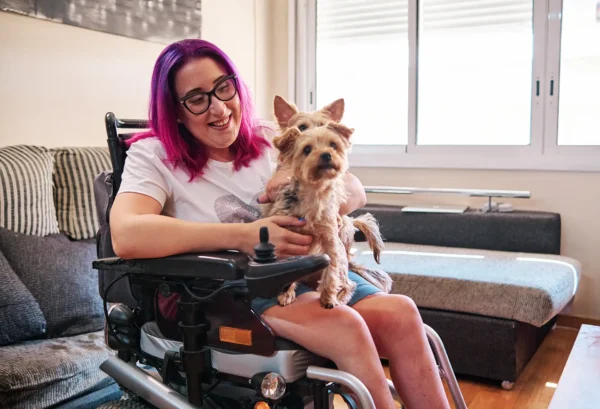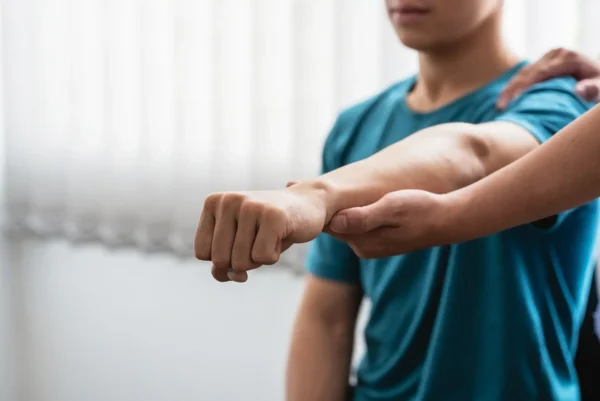What Causes Ehlers-Danlos syndromes?
Different types of Ehlers-Danlos syndromes are associated with one or more changes in the genes which carry the code for proteins in connective tissue. However, the exact gene is not always known. Most types of EDS are caused by defects in a protein called collagen, and all types of EDS involve a malfunction in the production of proteins which are important building blocks of connective tissue. In some types of EDS, such as hypermobile EDS, around 50% of children of affected individuals inherit the condition. In other cases, the likelihood of developing EDS is lower.
Symptoms of Ehlers-Danlos
 Ehlers-Danlos syndromes can be characterised by a range of symptoms depending on the severity of the condition. The condition itself is associated with joint hypermobility, stretchy skin, easy bruising, and abnormal scar formation following an injury.
Ehlers-Danlos syndromes can be characterised by a range of symptoms depending on the severity of the condition. The condition itself is associated with joint hypermobility, stretchy skin, easy bruising, and abnormal scar formation following an injury.
Other common symptoms include:
- Joint or spine pain
- Chronic pain syndromes, such as fibromyalgia
- Fatigue
- Recurrent joint dislocation or subluxation
- Muscle pain
- Soft, silky skin textures
- Stretch marks
- Lack of muscle tone
- Varicose veins
- Abdominal wall or groin hernia
- Uterine or rectal prolapse
- A drop in blood pressure on standing
- Postural orthostatic tachycardia syndrome (POTS) – an increase in heart rate on standing
- Gut problems, such as heartburn, nausea/vomiting, irritable bowel syndrome, and difficulty passing stool.
Types of Ehlers-Danlos Syndromes
There are currently thirteen classified types of EDS – a patient’s symptoms are matched up to the criteria to identify the type of EDS that fit. However, most of these conditions are rare.
The thirteen conditions are:
- Hypermobile EDS
Characterised by prominent generalised joint hypermobility.
- Classical EDS (cEDS)
Characterised by joint hypermobility, stretchy skin, easy bruising, and abnormal scarring.
- Vascular EDS (vEDS)
Due to an abnormal variant in the gene COL3A1, resulting in an increased risk of aneurysms, fistulae and rupture of blood vessels.
- Arthrochalasia EDS (aEDS)
Associated with bilateral hip dislocation and severe joint hypermobility.
- Brittle Cornea Syndrome (BCS)
Characterised by a thin and bulging cornea covering the eye, as well as the whites of the eye turning blue.
- Cardiac-valvular EDS (cvEDS)
Characterised by severe dysfunction with heart valves.
- Classical-like EDS (clEDS)
Similar to classical EDS, but caused a disruption with the basement layer of muscle, instead of defective collagen.
- Dermatosparaxis EDS (dEDS)
Associated with extreme skin fragility from birth.
- Musculocontractural EDS (mcEDS)
Associated with muscle contractures from birth.
- Myopathic EDS (mEDS)
Characterised by low muscle tone and/or shrinking of muscles.
- Spondylodysplastic EDS (spEDS)
Associated with short height and bowing of limbs.
The most common types are hypermobile EDS (hEDS), classic EDS, vascular EDS, and kyphoscoliotic EDS.
How is Ehlers-Danlos Syndrome Diagnosed?
 Ehlers-Danlos syndromes can be suspected after taking a thorough history and examination. The physical examination is used to help identify the degree of hypermobility in an affected individual’s joints, as well as to identify any other additional features of EDS. Genetic tests sampling an individual’s blood are also used alongside an examination of symptoms to confirm a diagnosis, however, this is only able to detect some forms of EDS and help to rule out other potential problems.
Ehlers-Danlos syndromes can be suspected after taking a thorough history and examination. The physical examination is used to help identify the degree of hypermobility in an affected individual’s joints, as well as to identify any other additional features of EDS. Genetic tests sampling an individual’s blood are also used alongside an examination of symptoms to confirm a diagnosis, however, this is only able to detect some forms of EDS and help to rule out other potential problems.
Ehlers-Danlos Syndrome Treatment
Whilst there is no current cure for EDS, the goal of treatment and therapy is to manage symptoms and address potentially life-threatening complications, such as aneurysms, fistulae, and rupture of blood vessels. Below are some of the different types of symptom control:
- Physiotherapy – doing exercises to develop muscle and joint strength.
- Occupational therapist – to obtain advice on the equipment that can help with day-to-day tasks.
- Cognitive behavioural therapy – to help learn how to manage the pain.
- Pain management – painkillers, such as anti-inflammatory medications, may be useful for acute episodes of pain. However, most individuals will require specific medical treatment for chronic pain through their GP and/or specialist.Medicinal cannabis can be considered when first-line licensed therapies have not achieved adequate pain control
Using Medical Cannabis for Ehlers-Danlos Syndromes
There are 13 types of EDS with varying symptoms, but all are affected by hypermobility which can cause chronic muscle and/or joint pain. The pain and associated symptoms, such as fatigue, can have a negative impact on a patient’s day-to-day life. Medical cannabis can be prescribed for eligible patients who are struggling to find relief from these symptoms.
Dr Simon Erridge, Research Director at Curaleaf Clinic says “Chronic pain is the most common reason why medical cannabis is prescribed according to the data we have analysed from the UK Medical Cannabis Registry. Within these we see a sizable proportion of individuals with chronic pain secondary to EDS or hypermobility spectrum disorders. Thanks to the contributions of patients, we are currently conducting a study at Curaleaf Clinic using the UK Medical Cannabis Registry which assesses the outcomes of patients with EDS that we see.”
To read more about chronic pain and medical cannabis read our published research from the UK Medical Cannabis Registry here.
Check your eligibility for a consultation today and speak to a doctor who specialises in chronic pain and can help you find a care plan that’s right for you.

